Are you confused why all of a sudden your Cockatiel is plucking its feather? Well, don’t you worry! Your pet bird is simply bored or may be frustrated! Knowing about the differences and uniqueness hidden under the behavior of Cockatiels can help you to understand and help them even better.
At this point, you might be thinking, what’s the difference in behavior of Cockatiels compared to other birds? Well, you’ll be amazed to hear that Cockatiels can do mimicry, they are affectionate in nature, make different sounds for communicating, etc.
So, in order to understand this family-orientated pet, it’s time to understand their behavior. In this article, we’ll explore the different versions of Cockatiels according to their behavioral patterns in various stages of life. Let’s begin the learning –
Male Vs Female Cockatiel’s Behavior
Just like us, Cockatiels’ behavior slightly differs depending on their gender. Here’s a peek into the differences other than their charming personality traits in the table below.
| Traits | Male Cockatiels | Female Cockatiels |
|---|---|---|
| Vocalization | 1. Louder 2. Can mimic properly 3. Can sing longer periods of time | 1. Softer and sweeter 2. Can mimic properly |
| Social behavior | 1. Extrovert 2. Easy bonding with other birds | Pickier while choosing mates |
| Courtship behavior | Holds their crests higher | Lower their crest and nibble |
| Traits during the Breeding season | 1. More territorial 2. Sing loudly 3. Aggressive toward enemy 4. Caring for mates | 1. Protects the nest and eggs 2. Aggressive toward any potential threats roaming around their nest |
Beginning with the vocalization, male Cockatiels tend to be more vocal. They whistle louder and mimic more precisely. Even the male ones can sing over an extended period of time and do it frequently.
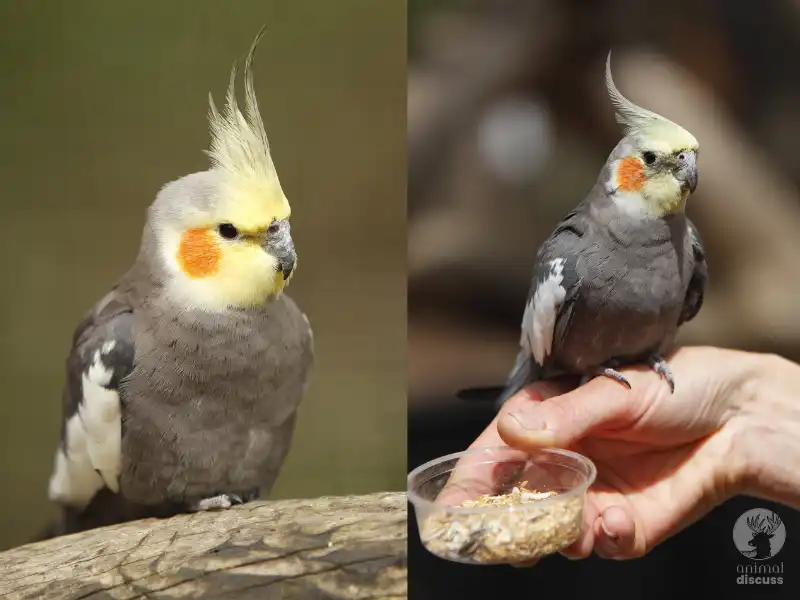
Whereas, female Cockatiels’ voices are softer and sweeter. They have equal potential in mimicking just like the male ones.
Secondly, the male ones are more extroverted in nature. As a result, it’s easier to bond with and grab the attention of other members. Thus, to impress potential mates, they love to show their skills.
On the other hand, the female ones are very meticulous in choosing with whom they’ll interact and form bonds.
Other than this, they’ve differences in body language too. As the male during courtship portrayal, holds their crests higher along with puffed-up feathers. But the female ones remain relaxed and hold their crests lower. They show affection through nibbling.
You can also see the differences during their breeding time. For example, males become more territorial. They sing loudly and chase their enemy. Even they vomit food for their mates.
And the female one during breeding seasons takes the leading role in protecting the nest and eggs. Even if needed, they’ll hiss or bite any potential threats roaming around their nesting area.
Care to learn more about Cockatiels? Follow up this article!
What Does A Cockatiel’s Crest Say?
Cockatiels have a beautiful crest and through it, they show different signs of communication like curiosity, excitement, fear even aggression. It depends on the situation and their body language signals. Let’s break it down for you –
Curiosity
When your Cockatiels are curious about something, they keep their crest a little raised, their head held high and their eyes wide open.
It’s quite normal and they’re showing that they’re engaged and interested in what’s going on around them.
Excitement
When this cheerful energetic bird raises its crest completely along with some happy chirping and doing some movements like dancing etc., it shows that the bird is excited.
You can see this behavior such as receiving a treat or when they want to play. Even when they enjoy your company, they like to do this to show you they’re happy.
Fear
Cockatiels get scared with loud noises or when they encounter an unknown person. During that period, they raised their crest along with flattened feathers. But their eyes are narrowed, and their posture is more scooched.
It takes time for them to get normal when they encounter unfamiliar situations. Try not to pet them at that time. Move slowly and calmly around them.
Aggression or Territoriality
As birds cannot speak when they see potential threats or enemies, they make sounds, and Cockatiels do the same too, they hiss.
Along with that, their crest is raised with feathers puffed up, and their beak is lowered down too which shows that they are in aggression. Let them calm down by giving them some space.
Well, remember that every Cockatiel is different from each other, and their crest movements may vary slightly. By observing your bird’s way of behaving in a particular situation you can understand its way of communication.
How Does A Cockatiel Communicate?
Cockatiels are playful and active birds who have surprisingly different types of ways to communicate with you. Quite amazing right? Let’s start with their common behavioral characteristics to notice what they are trying to say and behave in that particular manner.
Screaming
When your dear pet is screaming, it might create a panic situation for you. But simply the most common reason for their screaming is having an unwanted change or loud noises around them.
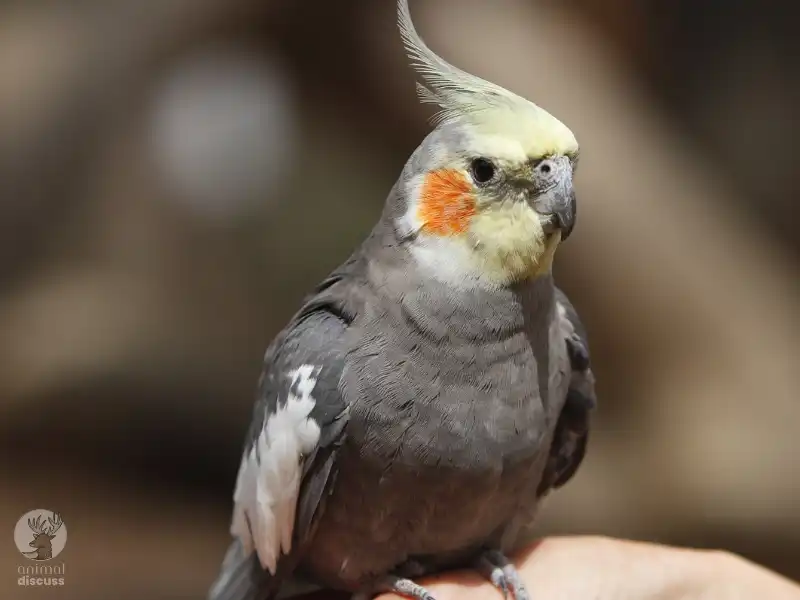
Even, they scream when their owner leaves them alone, as they cannot leave alone if they’re caged. Moreover, when they don’t get proper 10-12 hours of sleep daily, it makes them cranky too, which results in screaming.
Beak grinding
Don’t get tense seeing your favorite pet grinding their beak. They are simply either preparing themselves for taking a nap to relax or for when they are sleepy.
Beak grinding has nothing to do with beak trimming; rather, it’s all about ensuring that your Cockatiel is comfortable and feeling well.
Hitting objects
If you observe your Cockatiel engaging in throwing objects, it is likely seeking your attention. Due to being bored or annoyed, they do so. And to get your attention, they use their beaks to strike objects.
Some Cockatiels do it to show that it’s their territory and no one is allowed here. It is inappropriate to confine them in cages continuously due to this reason.
Cold feet
Your Cockatiel’s feet remaining cold symbolizes a bigger sign of them getting aged or they’re infected or they’ve poor blood circulation etc.
A healthy Cockatiel will have warm feet, which signifies that it’s healthy and happy. So, if you’re slightly confused that they’re sick or not through seeing changes in their behavior, check their feet.
Hanging upside down
You may notice suddenly that your bird is hanging upside down. Or they keep their wings open and flapping aggressively.
The reason for this behavior is that your Cockatiels need either spray misting or they desperately want to have a bath. Try to understand their necessities and help them to have them.
Inflated yawning
It might seem cute and problematic at the same time seeing your Cockatiel opening their beak widely for yawning.
Either they’re trying to breathe properly or their ears are blocked or they want to clear their throat from dust etc. are the probable reasons. Try to take it seriously as it might be a sign of respiratory problems if it comes with head-bobbing.
How To Understand That Your Cockatiel Wants Your Attention?
Cockatiels, our sociable birds, possess a remarkable ability to communicate their desires with us. If your cockatiel desires your attention, there are several hints, those are –
Using their vocals as a hint
Cockatiels when chirping or whistling directed towards you, it’s a hint that they want to have interactions with you. It’s their version of calling you to have a chat.
Moreover, when they do an adorable rhythmic bobbing of their head along with chirping, it commonly symbolizes that they want to be friends with you.
Changes in body language
When your favorite pet wants to say that you’re their favorite too, they show it by showing affection. A common way of showing affection is if your Cockatiel sits on your shoulder or arm and proceeds to brush your clothes or skin.
Besides, Cockatiels love mirroring your actions. And they do it by observing you and tracking your movements. They possess a keen curiosity and want to actively participate in what you’re doing by noticing whatever you do.
Moreover, as I’ve already mentioned, Cockatiels are fun-loving birds! So, if they drop their toys at your feet, it’s a sign that they want to play with you.
Another way of seeking attention is if this pet bird extends and inflates its wings, it could indicate excitement. Particularly, if it does so while vocalizing or moving up and down, they are fully prepared to engage in play and conversation!
Lastly, are you amazed by seeing your dear bird tapping you gently on your hand or cheek? It reflects that they trust you and are looking for some head scratches or cuddles.
Regurgitating as a display of affection
It might sound gross but it’s a common way for Cockatiels to show their affection. They move their head back and forth, pump their neck, crop muscles, and regurgitate some food for you.
Biting you
If you observe your Cockatiels engaging in biting or scratching behavior towards you, it may indicate their resistance to physical contact or their expression of anger.
If they exhibit such behavior, it would be advisable to let them have a period of seclusion in order to regain calmness.
Hissing at others
Cockatiels are very friendly in nature but when they don’t know someone in the room, they start hissing. It’s their sign of showing that they’re frightened and want your attention to protect them.
Try to make your Cockatiels friendly with other family members so that they don’t get scared or afraid of unknown faces.
Shaking head up-down
If you own a baby or a comparatively young Cockatiel, you may notice that it makes a noisy sound while moving its head in a vertical motion. It means that it is extremely hungry.
Usually, baby birds are taken from their parents after they’re independent. But in the event of a lack of a parental bird, this acts as a reminder to initiate the process of feeding the young bird.
Continuous pacing back and forth
Cockatiels pacing back and forth multiple times to show you their love.
Another probable reason could be they want to do their regular stretching by coming out of the cage. Or they’re simply bored and want your attention.
Resting on one foot
Well, surprisingly, Cockatiels resting on one foot during noontime or bedtime is not a matter of concern. They do it to settle down, which helps them to rest their legs for a while.
Plus, it’s a sign that they’re healthy. If you see them resting and alternatively changing feet to give them some rest, don’t be puzzled.
How To Detect A Happy Or Angry Cockatiel Through Its Behavior?
Mostly, Cockatiels are happy birds. You can see them singing, dancing, talking or making noises while they’re happy. These are a few signs through which they show that they are content. They even flap their wings, and shake their tails, which says that they’re happy.
On the contrary, when they raise their wings, hissing, chasing other birds, biting, etc., it’s a sign that your non-hostile bird is angry.
Why Does My Cockatiel Bite And How To Stop?
As discussed earlier, there are several reasons your pet Cockatiels may bite. They convey a message through this behavior such as being scared, angry, or drawing your attention, curious, territorial, or being so happy.
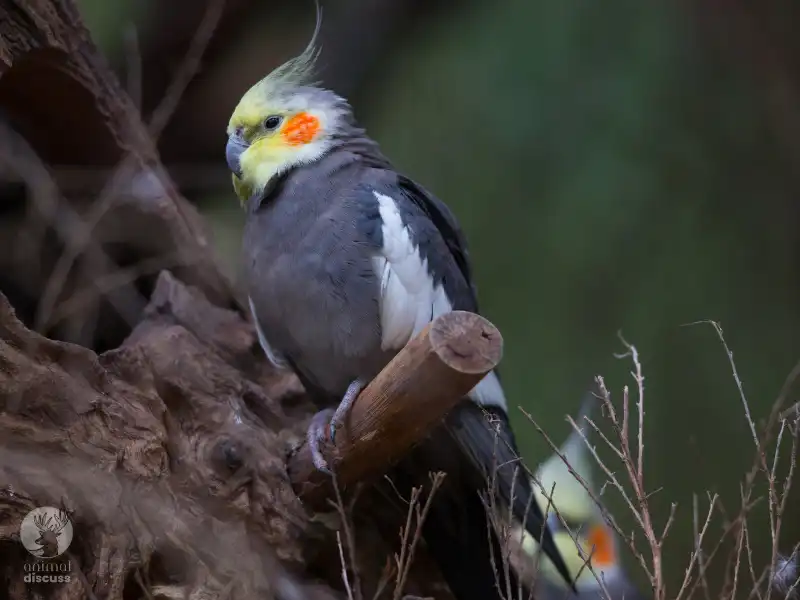
Though Cockatiels are sweet and playful birds, their biting can be disheartening sometimes. But is that poisonous? No, it’s rarely poisonous. But how to stop a Cockatiel from biting?
- Try to avoid putting your hand in the range of their beak.
- If they’re biting, don’t pet them or give treats to them. They can understand it’s wrong.
- If they’re already hissing, they’re already angry and don’t want you at that moment. So, it’s better to keep yourself away.
- Give your newbie pet a comfortable space where they feel relaxed. Otherwise, in the name of defense, they’ll bite you.
How To Detect A Sick And Hungry Cockatiel Through Its Behavior?
Cockatiels’ behavior changes when they are sick and hungry. It’s quite obligatory as a pet parent to focus on Cockatiel’s behavior so that they don’t suffer or get sick.
- When they’re sick, they refuse to eat or drink properly. Because of this, they don’t feel energetic and as a result, they sleep more.
- They have fewer signs of excitement in playing or communicating.
- Lose all the attributes of a healthy cheerful bird.
Other than their sickness, how to detect that they’re hungry? You may notice them scratching the floor of the cage, or biting, hissing, screaming, etc. What could be best for them is to have access to food 24/7 so that they can eat conveniently.
However, if you are really curious about their food and dietary habits, have a look at our article named “Cockatiels Buffet: What Do Cockatiels Eat?”
Behavioral Aspects of Cockatiels in Captivity: Old Pets vs New Pets
When Cockatiels come to an unknown place, they try to keep themselves hidden in the cage. They try to distance themselves from interaction with others and do hissing or biting due to being skeptical about the new place.
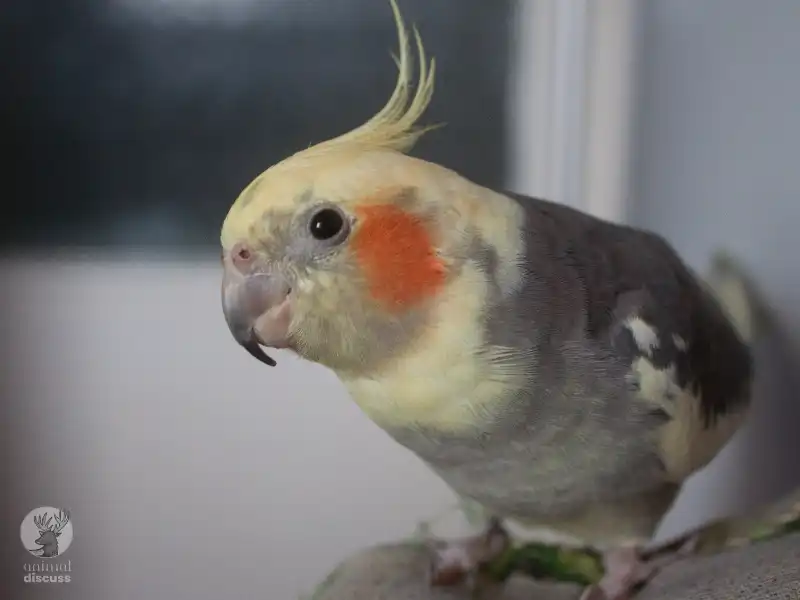
It can be a big reason for them to sleep less than usual for the discomfort. Moreover, these funny chatty Cockatiels become less vocal and refuse to sing or talk.
Therefore, it’s noticed that they try to fly away from the cage due to having distress or discomfort in the new space.
So, as a pet parent, you must understand their behavior and give them a comfortable space. Thus, they will be able to interact, mimic or play around just like any other Cockatiel.
Whereas, the old Cockatiels’ behavior is completely opposite. Due to remaining in the same place for a longer time, they get comfortable.
But older Cockatiels have weak feathers, low weight and physical weakness. This impacts irritable behavior and changes in their vocalizations.
If you notice all of these, you need to monitor their health. So, they don’t get frequent infections or lose their appetite.
Can Seasonal Change Affect Cockatiels’ Behavior?
Yes, seasonal changes do affect Cockatiels’ behavior. Starting from their mood, and energy level, even changes in vocalizations are noticed.
Summer and Spring
Cockatiels are seen as more energetic and vocal in longer daylight hours. They sing frequently and they are more playful during this season. As a result, the chances of interacting with humans are higher in these two seasons.
Likewise, they love to clean themselves by taking baths in these two seasons comparatively more than in other seasons. This is because they feel fresh and active in warmer temperatures.
Fall and Winter
Unlike summers, fall and winter have shorter days. During these shorter days, Cockatiels feel less active. Hence, their chirping and whistling also decrease.
Even they sleep more than their regular daily dose of sleeping and are less keen to play or interact. However, due to low temperatures, they huddle near heat sources or fluff up their feathers to preserve some heat.
What Behavior Changes Are Noticed If Cockatiels Are In Stress?
Sometimes minor changes can irritate and imbalance the regular flow of Cockatiels’ life, which may lead to stress. Location changes, owner changes, loud noises, new people, etc. can be reasons for stress.
And because of these different behavior changes, Cockatiels are noticed as unable to eat properly. Thus, they lose weight. Moreover, often it’s noticed that they face the wall due to anxiety from the changes.
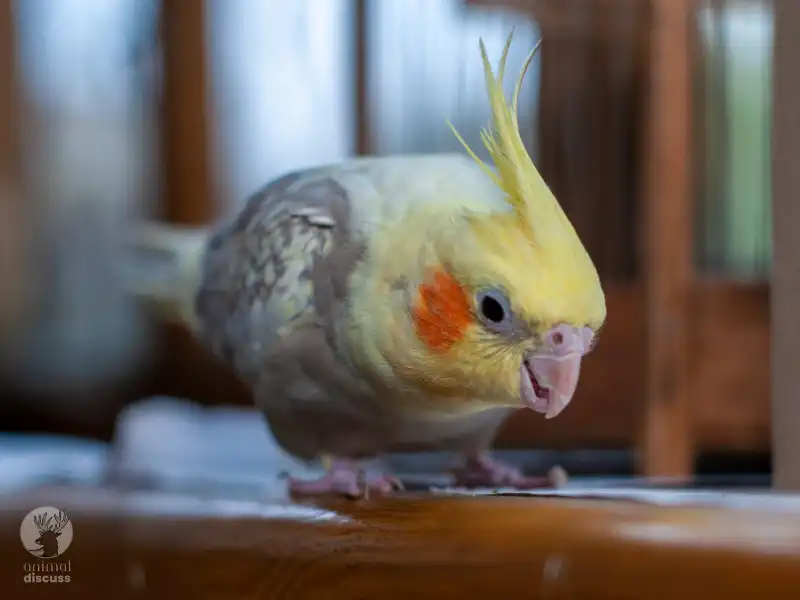
Furthermore, a common way of showing their discomfort is biting, and hissing. But it’s quite saddening that due to this discomfort, they harm themselves by feather picking.
Accordingly, remaining uncomfortable, they do not poop properly. It’s a sign that they’re stressed and getting ill. So, to make them comfortable, bringing a companion can be a great solution.
Cockatiels’ Behavior In Different Stages Of Life
Like seasons, Cockatiel’s behavior changes when it comes to behaving in different stages of life. We’ll explore the stage and the behavior below –
Stage 1- During Molting
Cockatiels shed once to twice a year which takes around ten weeks to be done completely.
In the molting process, Cockatiels shed their old feathers and get new ones. Thus, their mood becomes more frustrated, and short-tempered at that time.
And during molting, they need to do it all physically, so it consumes a lot of energy. This results in the bird feeling more tired. Hence, it’s better to feed them more in this stage. Plus, you should make sure they rest enough during this time.
However, if you’re noticing that they’re molting a lot of feathers other than the normal way, then it’s better to consult a vet.
Stage 2- Before Laying Eggs
They mostly prepare their nests for the eggs, and during this time they’re mostly active and restless.
Even they cleanse themselves comparatively more in order to prepare themselves for egg-laying.
One interesting behavior change you may see during this time is that they vocalize frequently to show their excitement for nesting.
Stage 3- After Laying Eggs
After laying the final eggs, both the male and female Cockatiels incubate the egg together. They do it by dividing their time, such as the male continues during the day and the mother at night.
While doing the process, both the male and female Cockatiels leave the nest for a very short period to bring food. They guard it and remain active so that the eggs remain safe.
Unusual Behavior Of Cockatiels
In the previous section, I have covered almost all the common behaviors of Cockatiels that are noticed. But what if you may witness some unusual ones? Well, you have to take them seriously in those cases, such as
Cockatiel Shivering
As I said, when a Cockatiel comes to a new place, it gets scared of the new environment, new owner, etc. This makes it frightened and shivers sometimes.
Other than that, if your Cockatiel catches a cold, it might shiver. Another reason for shivering can be when they’re nervous. Sometimes when new people invade their space, they fear them which can be the cause of shivering.
Cockatiel when squawking
Other than hissing or biting, Cockatiels are seen squawking when they’re anxious or scared.
Even the reason might be that it is hurt or mad about rotten food or unhealthy living space etc. If they’re making such a sound, check them properly and help them accordingly to get rid of that sound.
Cockatiel being quiet
How weird will it be when this chirping, whistling, fun-loving bird remains quiet all the time? But if you recently changed their environment, it’s quite normal.
However, if nothing such is done, look at their eyes and body movements. The probable reason for them remaining quiet is feeling negligent and sick. Try to immediately contact a vet.
Noticing sounds of thrashing
When the sound of thrashing is noticed from their cage at night, it simply means that they are scared of something.
In such a situation, you can keep a small light system available which can reduce their fear to some level. Otherwise, they might end up harming themselves in the darkness.
Constant sneezing
Sneezing is mostly done to clear nostrils by the Cockatiels. But it remains once or twice a day.
But if they cross the limit and the sneezing remains constant, it’s better to consult your vet.
Head bending and unbalancing
Other than having a proper view, birds’ head bending and unbalancing issues can be noticed due to their ear infections. Or they might have tumors or any neurological problems.
Try to keep it under observation and look for frequent changes.
Change in poop
When their poop size, color or consistency is changed, it symbolizes that they’re facing digestive issues. To resolve it, try to see the changes in poop for a few more days and consult a vet.
Behaving aggressively
If your Cockatiel is behaving aggressively toward other people or birds, it can be due to their hormonal changes, fear or pain.
It’s quite important to understand what has triggered this unusual behavior and get rid of it. So they can react normally and live peacefully.
How To Correct Your Cockatiels From Doing Unwanted Behavior?
Bad behavior is a sign that your pet friends are suffering either physically or mentally.
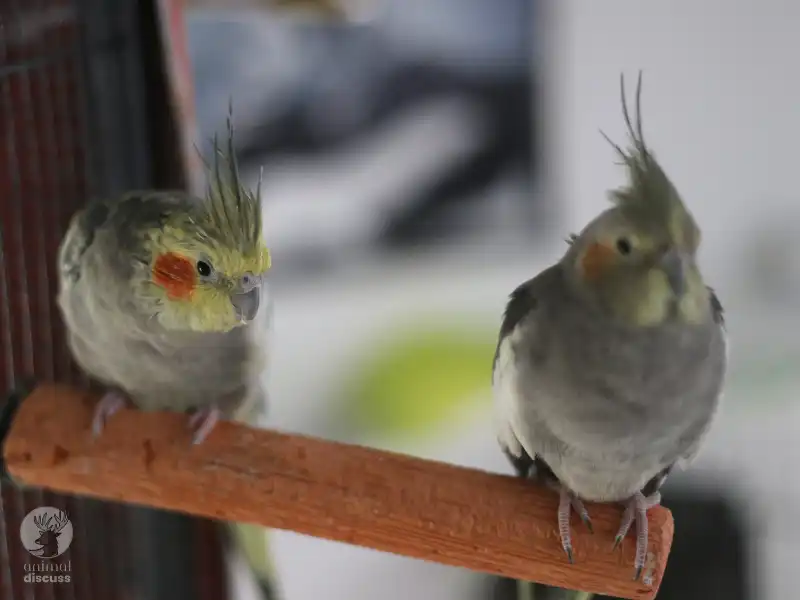
So, to ensure their good behaviors, a few things as a pet parent you need to do –
Ensure a healthy environment
A healthy environment means a place that is not completely isolated or not a place that is too noisy. Keep it in an environment where it can get proper sunlight, shade and fresh air.
Positive encouragement
It can be done by providing rewards such as treats, praise, head-scratching, or attention to pets as a means of encouraging desired behavior. This enhances the enjoyment of training for both parties involved. Thus, it increases the likelihood of their future good behavior.
If your birds are raising their voices to seek your attention, it is advisable to wait until they are calm and make pleasant chirping sounds. Then provide them with physical affection by gently scratching them.
Proper quantity and quality assurance of food
Your pet Cockatiel deserves the proper nutrients from the food. You can consult a vet and give it a healthy diet. And never forget to change its drinking water regularly.
Improve their surroundings
In order to ensure their emotional and physical entertainment, provide them with a variety of toys, resting spots, proper food availability, and opportunities for outdoor activities.
Cockatiels who experience boredom are more prone to engaging in negative or unwanted actions. To maintain their engagement and provide them with fresh challenges, regularly replace their toys.
Frequently Asked Questions
Now we will look for a few interesting questions to know more about the behavior of Cockatiels –
1. Is it possible for a Cockatiel to acquire the ability to mimic human speech?
Yes, definitely! Certain Cockatiels possess the ability to accurately mimic words, sentences, and even tones. It is a remarkable demonstration of their high intelligence and ability to learn.
2. How do you know if a Cockatiel likes you?
Well, you need to notice its behavior. That means if your Cockatiel loves you, it will preen, want to be cuddled, head bobs, act silly, and chirp happily when it’s near you.
3. Is it possible for a Cockatiel to live alone?
While Cockatiels survive in pairs or groups, a single Cockatiel may continue to survive with consistent human interaction and stimulation. To maintain their well-being, it is crucial to provide them with an abundance of toys, cognitive stimulation, and attentive care.
Conclusion
Every Cockatiel is different and unique. In this article, I’ve tried to explore Cockatiel’s behavior starting from how it communicates to unusual behavior traits; I’ve covered everything.
Other than that, never let your Cockatiels feel bored. Bringing new toys or playing around with them can help you understand the behavioral facts of Cockatiels even better. I hope that this detailed discussion will help you to be a good pet parent to your Cockatiels.

